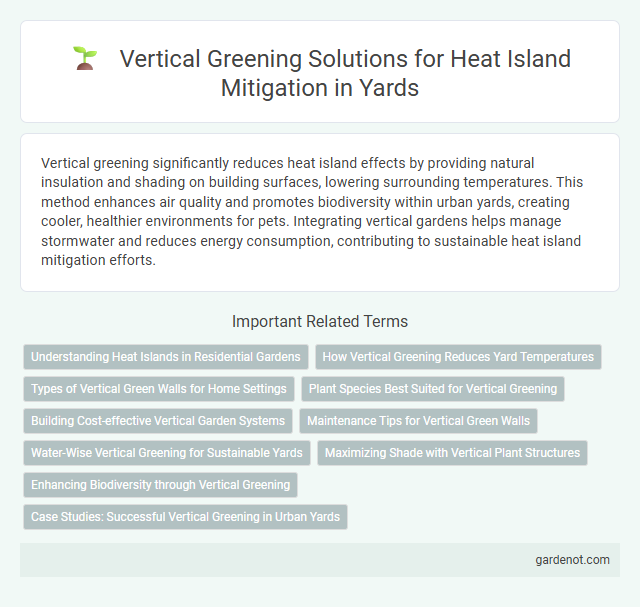Vertical greening significantly reduces heat island effects by providing natural insulation and shading on building surfaces, lowering surrounding temperatures. This method enhances air quality and promotes biodiversity within urban yards, creating cooler, healthier environments for pets. Integrating vertical gardens helps manage stormwater and reduces energy consumption, contributing to sustainable heat island mitigation efforts.
Understanding Heat Islands in Residential Gardens
Vertical greening in residential gardens significantly reduces urban heat island effects by increasing green surface area and enhancing evapotranspiration. Installing green walls or trellises with climbing plants improves shading and lowers ambient temperatures around homes. These methods not only mitigate heat accumulation but also promote biodiversity and improve air quality in densely built neighborhoods.
How Vertical Greening Reduces Yard Temperatures
Vertical greening significantly reduces yard temperatures by providing natural insulation that blocks solar radiation and minimizes heat absorption on walls and ground surfaces. Plants in vertical gardens promote evapotranspiration, releasing moisture that cools the surrounding air and lowers ambient temperatures. This cooling effect helps mitigate urban heat island intensity by creating shaded, thermally regulated environments in outdoor spaces.
Types of Vertical Green Walls for Home Settings
Vertical green walls for home settings include living walls, modular panel systems, and trellis-based climbers, each designed to optimize heat island mitigation by increasing insulation and promoting evaporative cooling. Living walls consist of soil or hydroponic layers supporting dense plant growth, while modular panel systems use pre-planted trays for easy installation and maintenance. Trellis-based climbers rely on vines growing on structures attached to exterior walls, offering a lightweight and cost-effective solution for reducing surface temperatures in urban yards.
Plant Species Best Suited for Vertical Greening
Vertical greening systems thrive with plant species like climbing ivy (Hedera helix), Boston fern (Nephrolepis exaltata), and flowering vines such as trumpet vine (Campsis radicans), which are highly effective in heat island mitigation due to their dense foliage and rapid growth. Succulent plants like sedum (Sedum spp.) also contribute by retaining moisture and providing insulation, reducing surface temperatures on vertical surfaces. Selecting native species adapted to local climate conditions maximizes survival rates and enhances ecosystem benefits in urban heat island interventions.
Building Cost-effective Vertical Garden Systems
Cost-effective vertical garden systems for heat island mitigation utilize modular panels made from recycled materials, reducing both installation expenses and environmental impact. These systems enhance building insulation, lowering urban temperatures while minimizing maintenance through drought-resistant plant selection. Integrating vertical greening into building facades significantly decreases cooling costs and improves air quality in densely populated areas.
Maintenance Tips for Vertical Green Walls
Regular pruning and watering are essential maintenance practices for vertical green walls to ensure healthy plant growth and prevent overgrowth. Monitoring irrigation systems and adjusting watering schedules based on seasonal changes helps maintain optimal moisture levels and reduces water waste. Periodic inspection for pests, nutrient deficiencies, and structural integrity extends the lifespan of vertical greening installations in heat island mitigation yards.
Water-Wise Vertical Greening for Sustainable Yards
Water-wise vertical greening systems enhance heat island mitigation by maximizing plant coverage while minimizing water consumption through efficient irrigation technologies such as drip irrigation and rainwater harvesting. Selecting drought-tolerant plants and integrating smart sensors for soil moisture monitoring optimize water use, promoting sustainability in urban yard designs. These strategies reduce ambient temperatures and improve air quality, contributing to long-term resilience against urban heat stress.
Maximizing Shade with Vertical Plant Structures
Vertical plant structures significantly enhance heat island mitigation by maximizing shade and reducing surface temperatures. Incorporating dense, multilayered vegetation on walls and fences creates natural barriers that cool surrounding areas through evapotranspiration. Strategic placement of vertical greening systems improves urban microclimates and promotes energy savings by lowering ambient heat levels.
Enhancing Biodiversity through Vertical Greening
Vertical greening, by incorporating a variety of native plant species on walls and facades, significantly enhances urban biodiversity in heat island mitigation yards. This method creates microhabitats for pollinators, birds, and beneficial insects, increasing ecological connectivity within urban areas. The layered vegetation structure supports diverse wildlife, contributing to a balanced and resilient ecosystem that effectively reduces urban heat.
Case Studies: Successful Vertical Greening in Urban Yards
Case studies of vertical greening in urban yards reveal significant reductions in surface temperatures, with temperature drops up to 5degC recorded on treated walls. Buildings equipped with living green walls show improved thermal insulation, leading to energy savings of approximately 15% in cooling costs. Urban yards utilizing vertical greening not only enhance biodiversity but also contribute to mitigating the urban heat island effect by increasing evapotranspiration and shading.
Vertical greening Infographic

 gardenot.com
gardenot.com